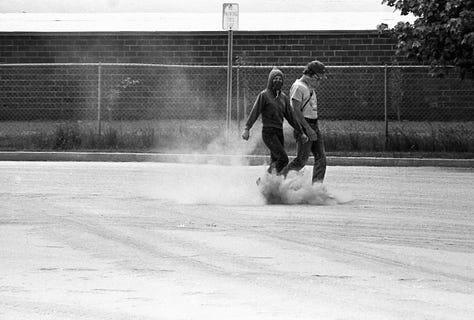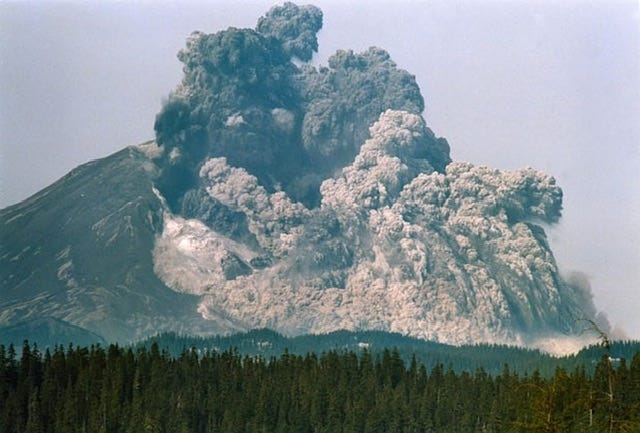Does the date May 18 mean anything to you? Think on it…
MAY 18th.
Since 1980, (that’s a hint, btw) for me, May 18th always means something pretty special—something magical but in ways that have evolved over the past 45 years. I lived through something incredibly dramatic and life-changing that, it seems, has faded from memory—including the lessons that we should continue to be learning, and heeding. This past May 18th, just a few days ago, I heard nothing from nobody about an event that occurred 45 years ago. An event that was epic—geologically speaking.
That would be Mt. Lawetlat’la (or “Loowit”), which means "smoking mountain.” Lawetlat’la is its Native name—given to it by the Indigenous, First Nations Cowlitz Peoples. When Capt. George Vancouver sailed off the mouth of the Columbia River in 1792, he renamed it Mt. St. Helens.
Side geological note: My state, Washington state, is “home” to five volcanoes each considered to be dormant (sleeping but active. NOT extinct. Each still has the potential to “awakin” or erupt in the future.).
Mt. Klickitat (Adams)
Mt. Tahoma (Rainer)
Mt. Dahkobed (Glacier Peak)
Mt. Kulshan (Baker)
And the above named Mt. Lawetlat’la (St. Helens).
(Note as well I champion the return of using the original, Native, Indigenous names to our landmarks. I use the names, here, given to these mountains by tribes in closest proximity—multiple tribes surrounding landmarks would use their own language or dialects, so it’s common to come across multiple names of the same landmark from the spoken Native languages in the area. Each should rightfully be honored and respected as well.)
On a clear day, which happens over 300 days of a year, from my home of youth in Moxee, from my bedroom window even, I could see both Mt. Klickitat and Mt. Tahoma.
Looking at that photo again, see how the prevailing winds are carrying the ash plume in the photo? The winds are blowing volcanic ash and pumice to the north and east of the fully awakened volcano. It’s doing that on May 18, 1980.
I lived to the north and east of Mt. St. Helens on May 18, 1980. I lived in an agriculturally fertile area called the Yakima Valley, in a small farming town called Moxee, four miles east of the small city of Yakima. At 8:32am PST, on May 18, 1980, a Sunday, the volcano that had slept dormant for 123 years, woke up with a fury. Fifty miles away (as the crow flies), in a modest two story home, in the middle of hop fields, in Moxee, in the small town east of Yakima, I lived in the direct path of that massive plume of ash, silica, minerals, and pumice.
The massive blast and subsequent landslides, flooding, and ash cloud killed 57 people, caused more than $1 billion in damage and destroyed at least 200 homes, and was heard more than 200 miles away.
The resulting scorching ash cloud reached as high as 16 miles into the atmosphere, darkening the sky and causing homes and businesses as far as 300 miles away to close. A massive wave of melted snow, ice, ash and pumice raced down the sides of the mountain, reaching up to 60 miles away and crushing homes, forests, bridges and roadways in its path. It took only two weeks for the ash cloud to circumnavigate the planet.
(USA TODAY, 2025)
Mt. St. Helens turned noon to midnight in my home town.
I was 14 years old then—nearing the end of my 8th grade year. And of all the days I’ve lived, I remember this day as among the most vivid of them all. No surprise, right? We woke up that Sunday morning just like every Sunday morning, to get ready for Sunday Mass (because, you know, Catholic). On that day, I remember we elected to go to 9:30am Mass, after our morning irrigation work, with Monsignor McGrath. My brother and I may have been scheduled to be alter boys that morning.
As we were getting ready at home, with no news or radio on in the house, we started to notice what we thought was a pretty big storm cloud heading our way—from the southwest. “That’s an odd shape for a storm cloud coming in,” my parents thought aloud. I remember the rest of the sky was clear and there was no wind. I remember it felt odd. The sky from that direction kept getting darker, and the cloud kept rising. Pretty soon, really soon as a matter of fact, we realized it wasn’t a storm cloud. “You don’t think the Mountain….”
Yes it did.
For months prior to the major eruption, Mt. St. Helens had been experiencing signs of “awakening:” quakes, slides, venting of steam, and the growth of a lava dome along its northern flank. We didn’t have the news on that morning, but once we understood, we turned on the radio to listen to the local live broadcast of breaking news for confirmation. You might wonder what we did then—knowing what had just happened 50 miles away, seeing what was currently happening in the skies above us, and not really knowing anything about what was to happen next?
We did what any serious Catholic family would do.
We went to Mass. (Because, you know, Catholic!)
“Is there a better place to be now? Might as well be in Church.”
Said no one in my family, I don’t think. We just did what we always did—and we never missed Church. I can’t remember any of us questioning going to Mass that morning even though I knew my parents were very uncertain, if not more than a little scared. I don’t think it dawned on them, so it didn’t dawn on my brother and me at the time, that we might be putting ourselves into danger by going outside. So we went to Church, though not as many of our neighbors did (who’re the REAL Catholics, y’all?); I know we prayed differently that morning.
We grew hops in the Yakima valley. By May 18th, hop bines had already been trained to grow up the trellis twine. The crops were growing. No one was sure what was going to happen to all the agricultural crops that were about to be covered in volcanic ash.
I remember early in the eruption, just before I think we left for Mass, we put out some containers to “capture” some of the falling ash. At the time, we didn’t know how long that eruption would last; at the time we didn’t know how much ash would fall. Containers of collected ash = souvenirs of the moment! Turns out, the entire region of the Yakima Valley had over 3 to 4 solid inches of the grey, abrasive, sand-like consistent ash that Lawetlat’la had redeposited from her bowels. Turns out we didn’t need the containers. Turns out, the ash was forever going to be a part of the region. We forgot to remember (see below).



When I was younger, 45 years seemed like forever. It takes an indelible event, remembered 45 years later, to remind one’s self that 45 years, especially in geological terms, ain’t nothin’. Because of those memories created when we lived through it intimately, the eruption of Lawetlat’la in some ways seems like yesterday. To Lawetlat’la, it was yesterday. In fact, to her, in her geologic time, it probably feels like just a minute ago. Over the course of those years, for me, the meaning found in the eruption of May 18, 1980, has evolved. I see things related to that event differently. I’m trying to “get” what Mother Nature be teachin’. Here’s a little of what I’ve learned, from the Mountain, about the eruption and about life in general because of the Mountain, as time has passed:
We humans cannot fathom the immense power, majesty and potential for utter “destruction” that Mother Nature can impose. Or her beauty. Maybe, that is, until we personally live through one of Her reminders. But, not really even then. Mother Nature is more powerful than we can imagine, more even than we’ve seen so far—we humans are simply along for the ride, completely at Her mercy. Mother Nature, in all senses of the word, is AWESOME. “Destruction” is our conceptualization—same with “natural disaster.” To Mother Nature, these are simply times for a clearing out, for more life, with maybe greater diversity, to evolve. To us, Her actions can seem quite dramatic; for Her, it’s probably just another moment. She’s had a lot of them. She’ll have more of them.
The only power we have in competition with Mother Nature is to realize we’re not in a competition. We only have choices in how we act, in where we choose to live, in how we respond, and in what we do to all the environments in which we humans live. The best chance of survival we’ve always had with Mother Nature is to adapt. She will always make herself known. We need only to honor that, to recognize we are powerless in her awesome presence, and then adapt and respond if we, ourselves, want to continue to survive. All other animals do this by instinct; we humans have the choice.
(Related to the teaching above): We will always lose if we attempt to control or compete with Mother Nature. With every community built near oceans or rivers; in the paths of storms, tornadoes and hurricanes, or ash clouds; near fault lines or above subduction zones; on desert sands or frozen tundra; or at the base of volcanoes—in other words, for every community everywhere on the surface of Planet Earth—we are at Mother Nature’s mercy. And when She decides to act, She wins. The dinosaurs, when considered over the grand expanse of life “since the beginning,” are considered among the most successful of species given their longevity and diversity (over 165 million years worth of lived pre-history). It just took one single event, from the universal “Mother Nature,” an asteroid strike 65 million years ago, to put an abrupt end to their existence. By comparison, our genus “Homo” has been around for a measly two million years; our species, just three hundred thousand. Dinosaurs lived the ultimate Truth that Mother Nature’s will will always be imposed, no matter to what extent we puny humans insanely believe we can mitigate her power. A corollary to this teaching is one of my favorites: “Mother Nature ALWAYS bats last. And She’s undefeated.”
Even in the midst of utter and almost suffocating darkness, “good” things can result. I put “good” in quotes because it’s another human judgment—Mother Nature doesn’t judge like that. Things just are. Mother Nature just is. Period. At noon’s midnight on May 18, my family was worried about our crop of emerging hops. But we lived in one of the most fertile valleys in the world—because of its geologically active volcanoes. The soil in the entire region, over a millennia, has been enriched by the rich minerals of volcanic ash. We simply just continued farming—after plowing the ash into the soil and mindfully irrigating as the growing season kept on. I think it was determined that crop yields in the relative years directly following the major eruption increased. Even today, the ash from the May 18th eruption can be picked up when one picks up a handful of soil in any hop field, orchard, or pasture. And here we put out containers to catch ash!
Mother Nature’s wisdom is all inclusive and known only to her. She includes everything and everything is included in Her. Sometimes we understand her wisdom, sometimes we are left clueless. Regardless, Her ultimate wisdom is ungraspable by us humans. And yet we typically ask “Why us? Why here? Why now?” when She let’s slip her force. The best we can ever do is attempt, in retrospect, to join the pieces of the known world together, like the pieces of a puzzle whose final image we will never see, to create a meaning that is always artificial. Any thing humans make is artificial. Everything mother nature makes is always real. Humans create meaning—the only known species to do so in a conscious way. We do that in order to help make things make sense. Mother Nature has no need for meaning. Everything makes sense to Her.
Life will continue. As part of a geology course I took at the University of Washington, I was able to take part in a survey inside the blast zone at the base of Mt. St. Helens in the late 1990’s. Scientists were surprised at how fast life had re-emerged in the area. It was exhilarating to be there, knowing where I was in 1980, and knowing what was happening then at the exact spot I was standing.
This is what makes our Planet so miraculous. In all the near-infinite expanse of space in this Universe (humans have not yet discovered any “edge,” no matter how far we’ve yet looked; no matter how powerful the telescopes), this pale blue dot amidst the grand expanse of the mostly open, dark, and silent space, is the only home to life. At least as we know it now. If all the given evidence and scientific laws continue to hold, life will continue. But maybe not ours. Likely not ours. Species come and go. Our species has come, and it, too, will go. But LIFE…. LIFE will continue in some form. It seems the only thing that will stop it, now that it has begun, is the total annihilation of the planet itself—eg, something on the nature of a planetary catastrophe that turns our planet into chunks of cold rock and debris. This may be when our Sun, Herself a part of Mother Nature, decides her life has come to a close as well; or some as yet not seen comet finds itself on a direct collision course.
It happens.
That would be the Universal Mother Nature, too.
I love that I lived through the May 18, 1980 eruption of Lawetlat’la. Those are amazing and awe-inspiring memories. If we are influenced most significantly from the events moving through our adolescent years, and I believe this to be largely true, then I can say with certainty that I have been influenced by a Mountain I lived 50 miles from. And on a calm and pristine morning on a lazy Sunday, one May day in 1980, my life and future changed because She woke up. I said above She woke with a fury. That, again, is a human judgment. Lawetlat’la, Mt. St. Helens, was just doing what She does. She’ll do it again, too. Same with Tahoma, and Klickitat, and Dahkobed, and Kulshan. I might not be here to bear witness to any more of these Mountain awakenings, but that’s okay. I lived through one, I’ve got memories to prove it. In fact, as things are currently going, NO human might be around. But some forms of life will. A lot of life, as a matter of fact.
Because that’s what Mother Nature does. She nurtures and gives life to life. We don’t know in what inning this game of human life is in—has the game just started, are we at a 7th inning stretch, or is it in the final inning? Who’s winning anyway? We can never really know until the final swing has been swung. But remember….
Mother Nature, with her pristine record, ALWAYS bats last.
Always and Ubuntu,
~ k
🙏🏼 💙















This is fascinating, Kert. And also thought-provoking.
My husband grew up in Portland and was visiting his family the week before the eruption. His parents' neighborhood was covered in ash. What an experience to live through.
I was down in San Diego, I remember it well. And I still do think of it from time to time. I don’t remember any ash making it as far as us. But I do remember hearing reports of it going pretty far, I guess we were the wrong direction.
I was really hoping you’d mention how it affected the soil and crop yield. Because I know of people adding ash or charr to soil, so glad to hear that was a positive, like a giant free fertilizer delivery for everyone, that also happened to be quite messy to the non field areas.
What was it like walking home from church? Or driving…and being outside? How difficult was the cleanup?
I lived for seven years on the Big Island of Hawaii, so I definitely share that sense of being in the shadow of the boiling mountain. We had eruptions when I was there with whole house neighborhoods being slowly run over by the lava, the lava would be on the ground not over the house but the heat of it would just ignite the house and it would burn down as the lava kept moving slowly…so people had plenty of advanced warning to evacuate. Roads and beaches disappeared. A really favorite family beach for locals for generations just went away now covered by lava rock. I’ve seen the lava glowing at night coming down the hills. And all year long with ebbs and flows there can be stuff in the air called vog instead of smog, the v for volcano. There’s a daily vog report to let you know how the air will be. I kind of miss being near the volcano, but not so much the vog. I’ve also lived in cities with bad smog and definitely don’t like both, but the vog seems the more natural of the two and it comes with beautiful Hawaiian island life.